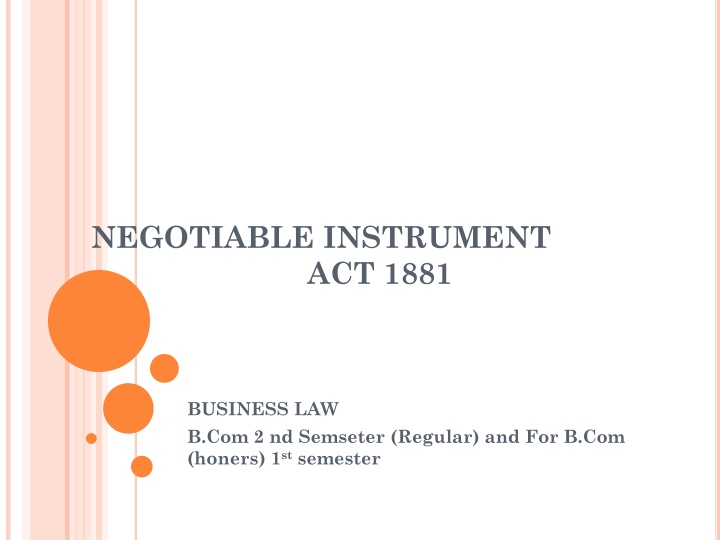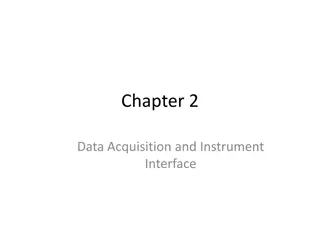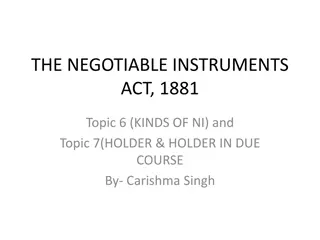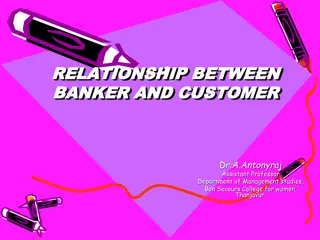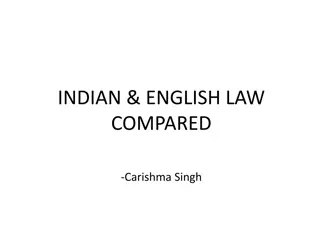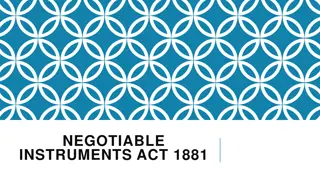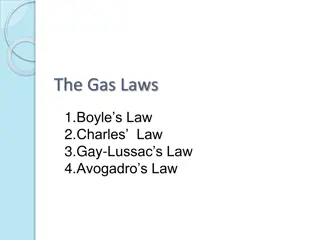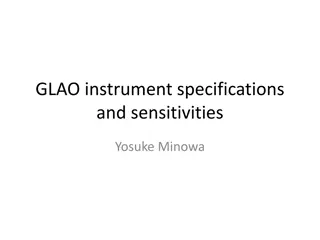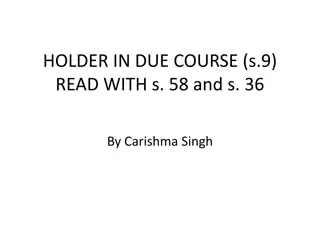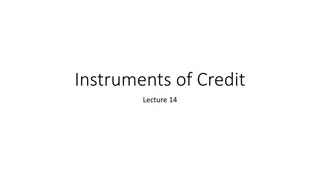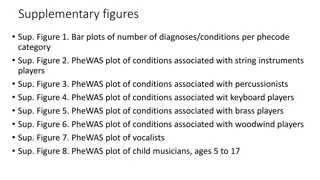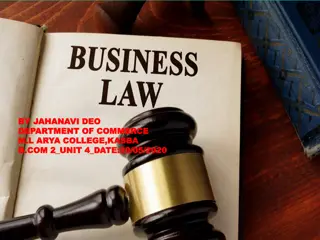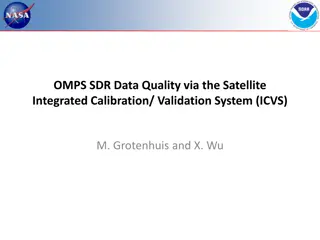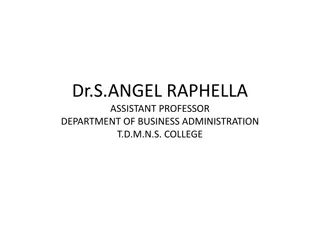The Negotiable Instrument Act of 1881 in Business Law for B.Com Students
The Negotiable Instrument Act of 1881 governs the transferable nature of negotiable instruments like promissory notes, bills of exchange, and cheques. These instruments are freely transferable, created for consideration, and must have certain essential elements. The act provides rules for acceptance, transfer, and recovery of amounts related to these instruments. B.Com students studying business law will find this act essential for understanding financial transactions and legal obligations.
Download Presentation

Please find below an Image/Link to download the presentation.
The content on the website is provided AS IS for your information and personal use only. It may not be sold, licensed, or shared on other websites without obtaining consent from the author.If you encounter any issues during the download, it is possible that the publisher has removed the file from their server.
You are allowed to download the files provided on this website for personal or commercial use, subject to the condition that they are used lawfully. All files are the property of their respective owners.
The content on the website is provided AS IS for your information and personal use only. It may not be sold, licensed, or shared on other websites without obtaining consent from the author.
E N D
Presentation Transcript
NEGOTIABLE INSTRUMENT ACT 1881 BUSINESS LAW B.Com 2 nd Semseter (Regular) and For B.Com (honers) 1stsemester
The word negotiable means transferable from one person to another in return for consideration and an instrument means A written document by which a right is created in favor of some person . Thus, a negotiable instrument is a document which entitles a person to a sum of money and which is transferable from one person to another.
Characteristics of a negotiable instrument: Freely Transferable:- The property in a negotiable instrument passes from one person to another by delivery Consideration:- Every negotiable instrument is presumed to have been made, drawn, accepted, negotiated or transferred for consideration. Date:- Every negotiable instrument bearing date is presumed to have been drawn on such date. Recovery:- The holder in due course can sue upon a negotiable instrument in his own name for the recovery of the amount.
Time of acceptance:- When a bill of exchange has been accepted it is presumed that it was accepted within a reasonable time of its date and before its maturity. Time of Transfer:- Every transfer of a negotiable instrument is presumed to have been made before its maturity.
Types of Negotiable Instrument There are three types of negotiable instruments & these are: a) Promissory Note b) Bill of Exchange c) Cheque
Promissory Note A promissory note is an instrument in writing (not being a bank note or a currency note) containing an unconditional undertaking signed by the maker to pay a certain sum of money only to or to the order of a certain person or to the bearer of the instrument. (Sec.4) The person who makes the promissory note & promises to pay is called the maker & the person to whom the payment is to be made is called the payee.
Essential elements of Promissory Note Writing:- The instrument must be in writing. Writing includes print & typewriting and may also be in pen or ink. Promise to pay:- The instrument must contain an express promise to pay. The following instrument signed by A is not a promissory note: Ex. I am bound to pay the sum of Rs. 500 which I received from you.
Definite and Unconditional:- The promise to pay must be definite and unconditional. If it is conditional or uncertain, the instrument is invalid. Ex. I promise to pay B Rs. 500 when he delivers the goods. Signed by the maker:- The instrument must be signed by the maker otherwise it is incomplete & of no effect. Certain parties:- The instrument must point out with certainty as to who the maker is & who the payee is. Where the maker & the payee can t be identified with certainty with the instrument itself, the instrument even if contain an unconditional promise to pay is not a promissory note.
Certain sum of money:- The sum payable must be certain and must not be capable of contingent addition or subtraction. Ex. I promise to pay B Rs. 1000 and all other sums due to him. Promise to pay money only:- The payment to be made under the instrument must be in the legal tender money of India. If the instrument contains a promise to pay something in addition to money, it cannot be a promissory note. Ex. I promise to pay B 20 shares & 10 bonds of XY limited. It may be payable on demand or after a definite period of time.
Bill of Exchange A bill of exchange is an instrument in writing containing an unconditional order signed by the maker directing a certain person to pay a certain sum of money only to or to the order of a certain person or to the bearer of the instrument (Sec.5)
Parties to a Bill of Exchange Drawer:- The person who gives the order to pay or who makes the bill is called the drawer. Drawee:- The person who is directed to pay is called the drawee. When the drawee accepts the bill, he is called the acceptor. Payee:- The person to whom the payment is to be made is called the payee. The drawer or the payee who is in the possession of the bill is called the holder. The holder must present the bill to the drawee for its acceptance. When the holder endorses the bill, note or cheque, he is called the endorser. The person to whom the bill, note or cheque is endorsed is called the endorsee.
Essential elements of Bill of Exchange a) It must be in writing. b) It must contain an order to pay. c) The order must be unconditional. d) It requires three parties i.e., the drawer, the drawee & payee. e) The parties must be certain.
f) It must be signed by the drawer. g) The sum payable must be certain. h) It must contain an order to pay money only. i)The formalities like number, date, place, consideration etc are usually found in an instrument although they are not essential in law but a bill must be affixed with the necessary stamp.
Difference between Promissory note & Bill of exchange Promissory Note Bill of Exchange There are two parties. There are three parties. It contains an unconditional promise to pay. It contains an unconditional order to pay The maker of the note is the debtor & he himself undertakes to pay. The drawer of the bill is the creditor who directs the drawee (his debtor) to pay. The maker of the note is the debtor & he himself undertakes to pay. The liability of a drawer of a bill is secondary & conditional. A note cannot be made payable to the maker himself. In a bill, the drawer & the payee may be one & the same person.
Cheque A cheque is a bill of exchange drawn upon a specified banker and payable on demand and it includes the electronic image of a cheque or a cheque in the electronic form. A cheque in the electronic form means, Cheque which contains the exact mirror image of a proper cheque and is generated, written & signed in a secure system ensuring the minimum safety standard with the use of digital signature . Cheque is define under Sec 6 of this Act.
A cheque is the species of a bill of exchange but it has the following two additional qualifications: a) It is always drawn on specified banker. b) It is always payable on demand. All cheques are bill of exchange but all bill of exchange are not cheque. A cheque must have all the essential elements of a bill of exchange but it doesn t require acceptance as it is intended for immediate payment.
Difference between a bill of exchange and a cheque Bill of exchange Cheque It may be drawn on any person including a banker. It is always drawn on a banker It must be accepted before the drawee to make payment upon it. A cheque requires no acceptance. It may be payable on demand or after the expiry of a certain period after date or sight. A bill is never be crossed. It is always payable on demand A cheque may be crossed. A bill except in certain cases must be stamped A cheque doesn t require any stamp
Crossing of Cheques Open Cheque:- A cheque which is payable in cash across the counter of the bank is called an open cheque. When such a cheque is in circulation, a great risk attends it. If it s holder looses it, it s finder may go to the bank and get payment unless its payment has already been stopped.
Crossed Cheque: A crossed cheque is one in which two parallel transverse lines with or without the words & Co. are drawn. The payment of such a cheque can be obtain only through banker. Thus, crossing is a direction to the drawee banker to pay the amount of money on a crossed cheque generally to a banker so that the party who obtains the payment of the cheque can be easily traced.
b) Special Crossing: Where a cheque bears across its face in addition of name of the banker either with or without the words not negotiable , the cheque is deemed to be crossed specially. (Sec. 124)
